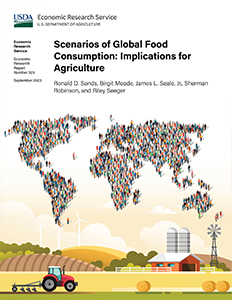Scenarios of Global Food Consumption: Implications for Agriculture
- by Ron Sands, Birgit Meade, James L. Seale, Jr., Sherman Robinson and Riley Seeger
- 9/21/2023
Overview
The global land base is under increasing pressure to provide food for a growing population. This report describes how increasing population, income, and agricultural productivity may affect global production and consumption of crops and food products by 2050. Results show that in an income-driven food demand scenario, production of world crop calories increases by 47 percent from 2011 to 2050. Demand for food calories and crop calories increases over time in all scenarios, with most of the adjustment through increases in crop yield (intensification). The amount of cropland also increases (extensification) but less on a percentage basis.
How to Cite:
Sands, R., Meade, B., Seale, Jr., J.L., Robinson, S., & Seeger, R. (2023). Scenarios of global food consumption: Implications for agriculture (Report No. ERR-323). U.S. Department of Agriculture, Economic Research Service. https://doi.org/10.32747/2023.8134356.ers
Download
-
Entire report
Download PDF -
Report summary
Download PDF

